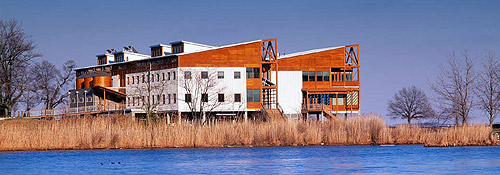Berkeleyan
 Energy use in the Philip Merrill Environmental Center in Annapolis, Md., is closely monitored. Natural ventilation is emphasized, with employees receiving a system alert when it's determined that windows should be opened. (Photo © Merrill Environmental Center) |
Saluting buildings that comfort and conserve
'Livable buildings' honored by the Center for the Built Environment all 'went the extra mile' in green design
![]()
| 08 November 2007
To recognize commercial buildings that do more than provide the space and tools for workers to toil away, the campus's Center for the Built Environment has issued its first-ever Livable Buildings Awards.
The center's kudos for building resource efficiency, architectural design, and occupant satisfaction are unique in the building industry because they consider the building users' feelings about features such as lighting, acoustics, and thermal comfort, says Edward Arens, the center's director and a Berkeley professor of architecture.
The 2007 Livable Buildings Award winners, announced in October, include the Chesapeake Bay Foundation's Philip Merrill Environmental Center in Annapolis, Md.; the low-energy laboratory and offices of the Global Ecology Research Center for the Carnegie Institution of Washington at Stanford University; and the Kirsch Center for Environmental Studies at De Anza College in Cupertino.
"They stood out as very livable buildings from the occupant perspective. They also went the extra mile in the execution of their designs," says Arens, adding that building occupants historically have been underutilized in helping to understand how a building performs.
 Natural lighting and the use of recycled, renewable, and non-toxic materials were among the student initiatives incorporated into De Anza College's Kirsch Center for Environmental Studies. Solar panels provide off-the-grid water heating. (Photo © De Anza College) |
"When the Chesapeake Bay Foundation decided to build a green building, we wanted a facility that was top-notch environmentally, that would inspire others to build green, and that offered our employees a high-quality work experience," says the foundation's vice president, Mary Tod Winchester. The Philip Merrill Environmental Center was the first building to receive the U.S. Green Building Council's Platinum rating for Leadership in Energy and Environmental Design (LEED).
The Kirsch Center is a 22,000-square-foot California Community College showcase for sustainability and energy innovation, thanks to the efforts of students, who pushed for solar energy, natural day lighting and ventilation, efficient heating and cooling, and the use of recycled, renewable, and non-toxic materials. The center has become a popular place on campus to study and socialize, and enrollment in environmental courses taught in the facility has skyrocketed.
The awards jury commended the designers of the Global Ecology Research Center for "creating a building that makes the expression of a sustainable ethic clear, but not overwhelming." The low-energy laboratory brings attention to important environmental issues identified by the Carnegie Institute, including water conservation and reducing carbon emissions from building operations.
To be considered for the award, buildings had to be among the top 10 performers in the Center for the Built Environment's Web-based Occupant Indoor Environmental Quality Survey, which has been conducted with more than 38,000 individuals in more than 320 non-residential buildings in North America.
"The finalists were not only culled from a huge database but have high marks in every category of our survey," says Arens. "If a building was fantastic but scored low in one category, it didn't make the cut. These buildings are the best of the best in terms of their survey results."
The survey collects occupant ratings of indoor environmental- quality features including thermal comfort, air quality, lighting, acoustics, cleanliness, spatial layout, and even office furnishings - all of which have a big impact on worker comfort and productivity.
The idea is to help building owners and operators make adjustments to existing buildings, and help architects, engineers, and builders construct better ones in the future. The survey also is sometimes used to gauge the performance of green-building design elements.
A seven-member jury of leaders from the building industry reviewed additional information submitted on the finalist buildings, including basic building characteristics, measured energy-use data, green-building features, and other information relevant to the buildings' intent and design.
The jury also selected two buildings for honorable-mention recognition: Donald Bren Hall at UC Santa Barbara, the first laboratory building to receive LEED platinum recognition; and the William and Flora Hewlett Foundation Building in Menlo Park, which has received LEED gold certification.
In addition to the winners and honorable mentions, the finalists included:
. Blakely Hall in Issaquah, Wash.;
. The Chicago Center for Green Technology in Chicago;
. The Department of the Interior National Business Center in Denver;
. McCuen Center One in Sacramento; and
. Swinerton Headquarters in San Francisco.
The Center for the Built Environment survey results, and photos of the 2007 Livable Buildings Award winners, are online at www.cbe.berkeley.edu/livablebuildings. Information about the occupant survey is online at
www.cbe.berkeley.edu/research/survey.htm.

